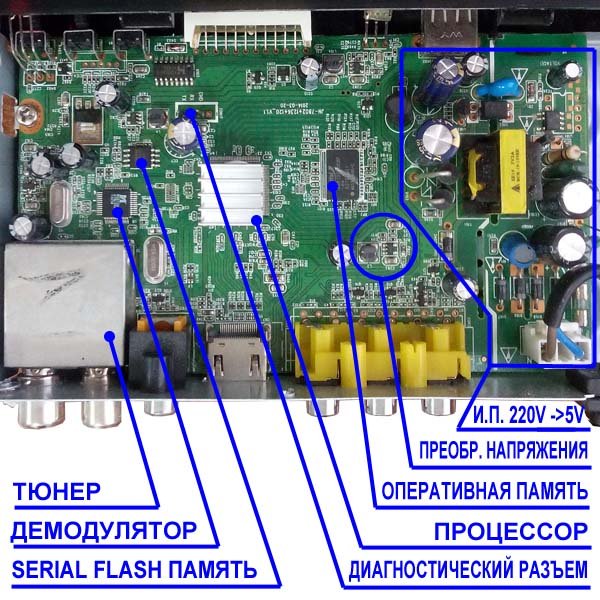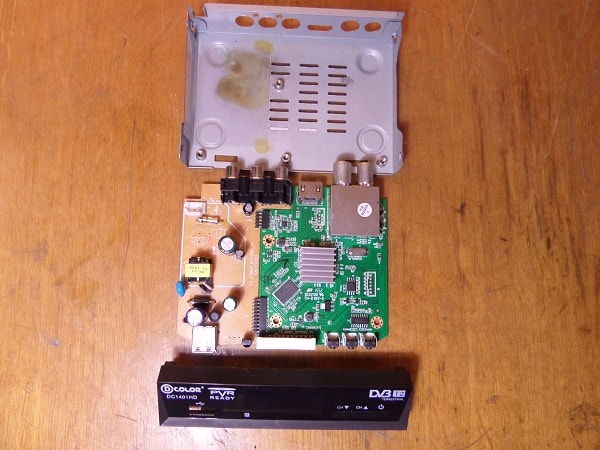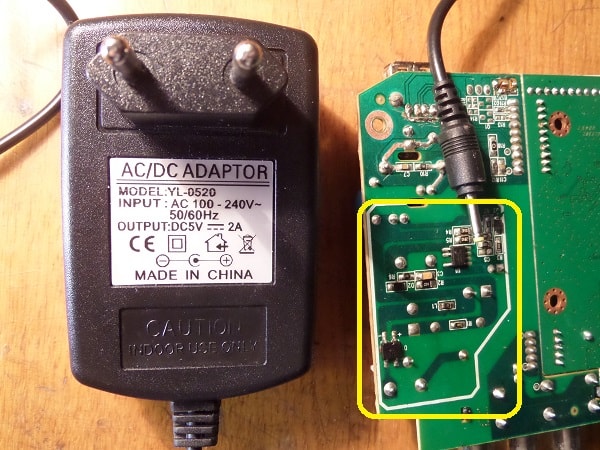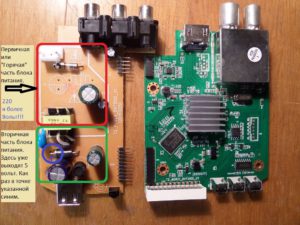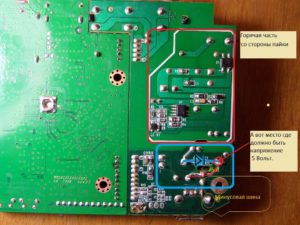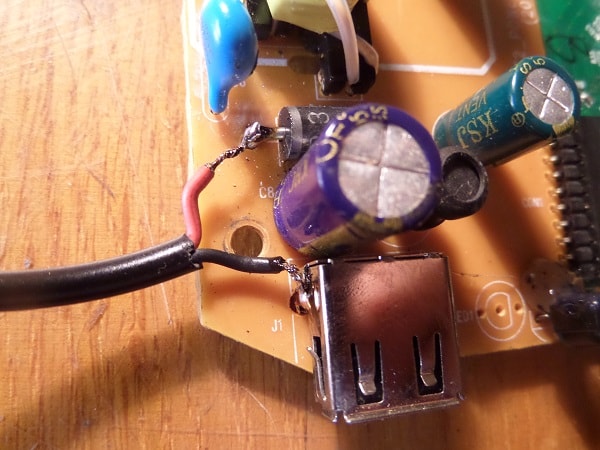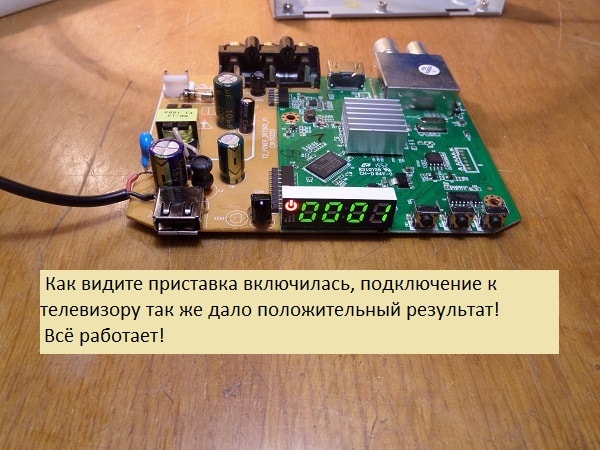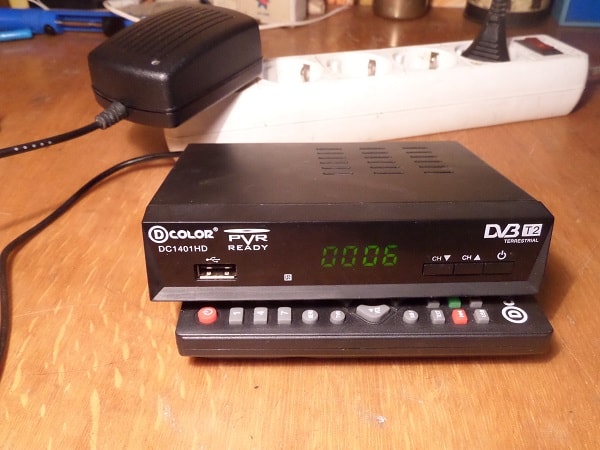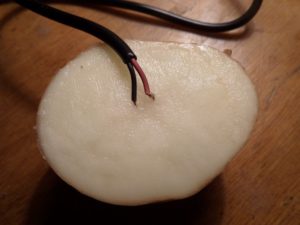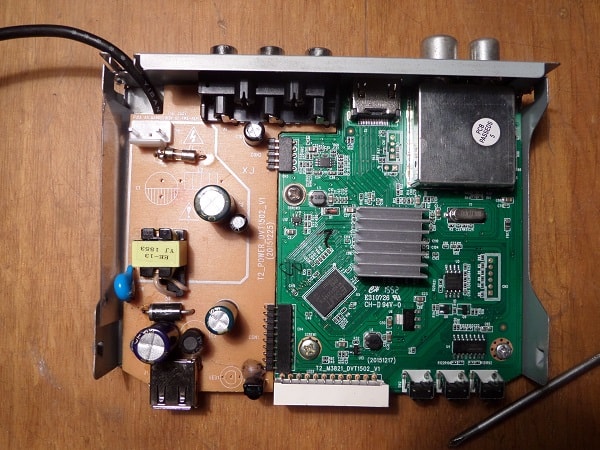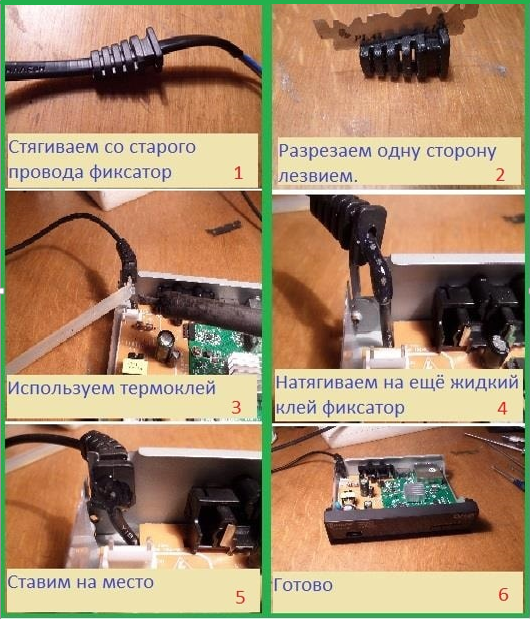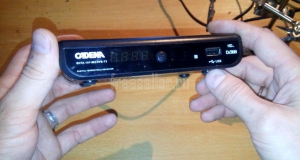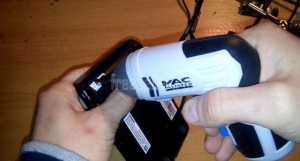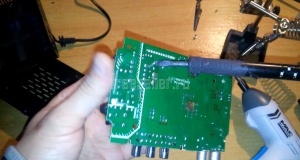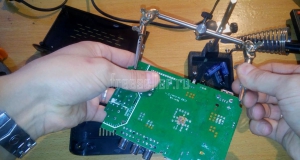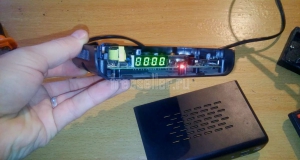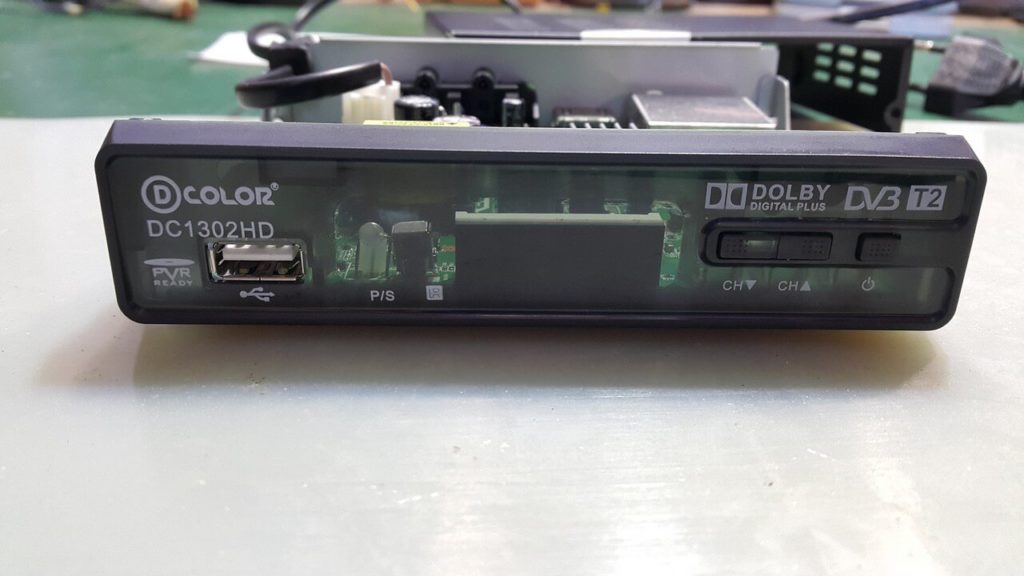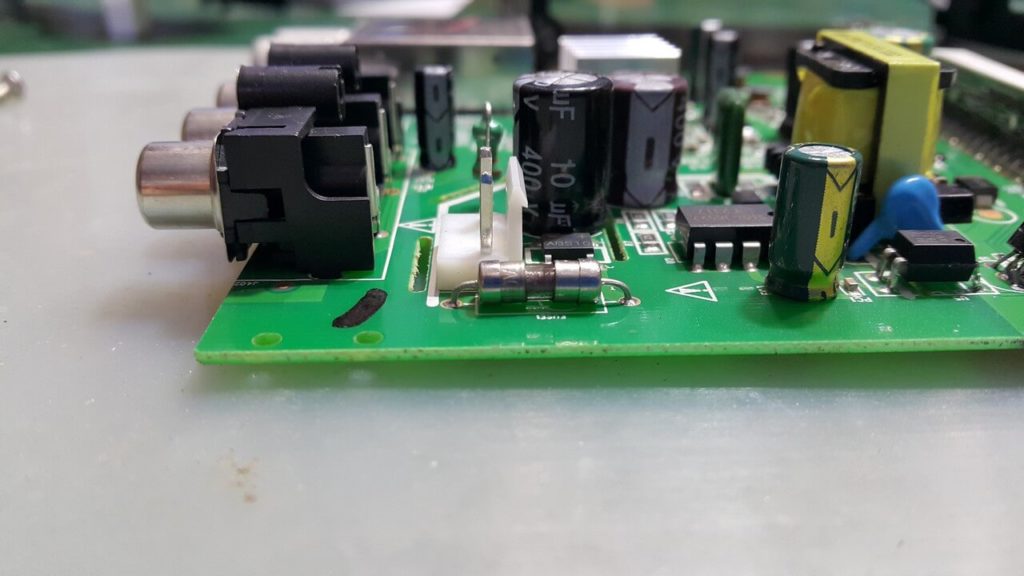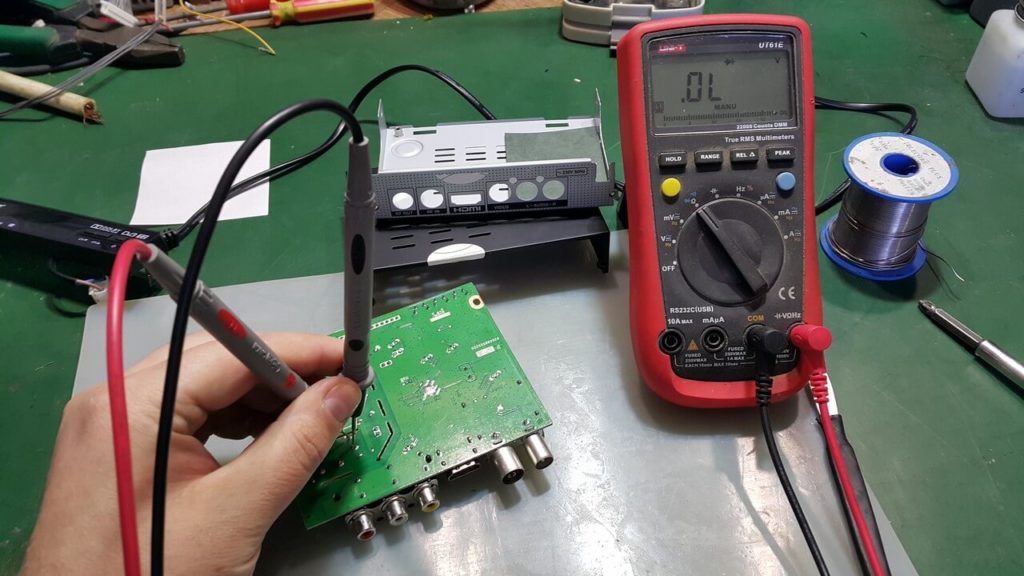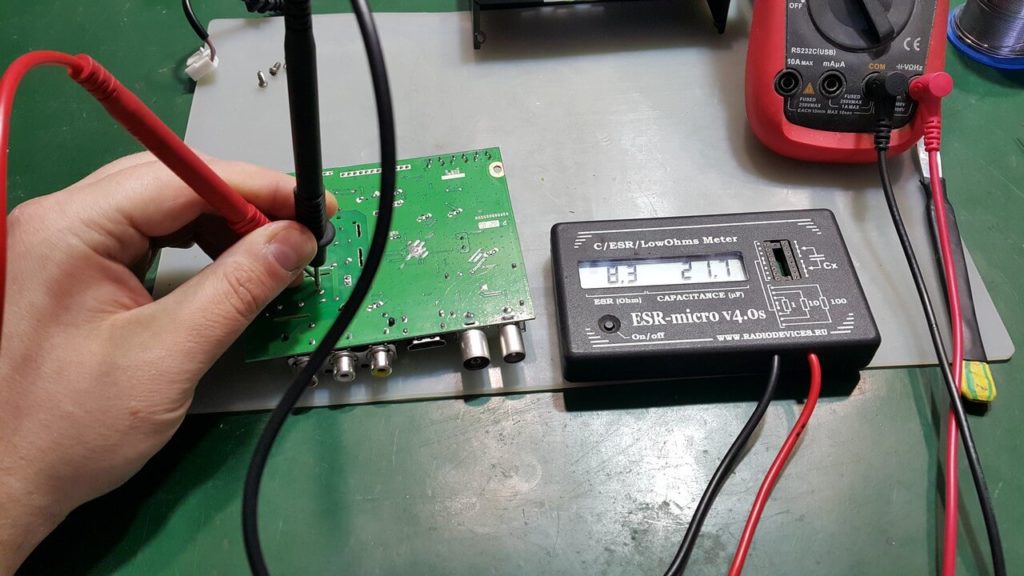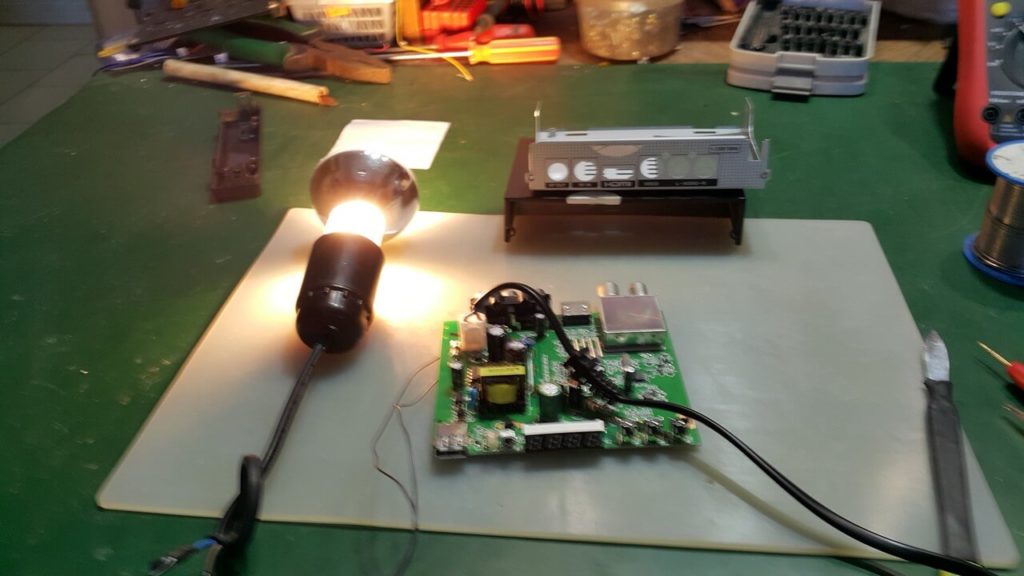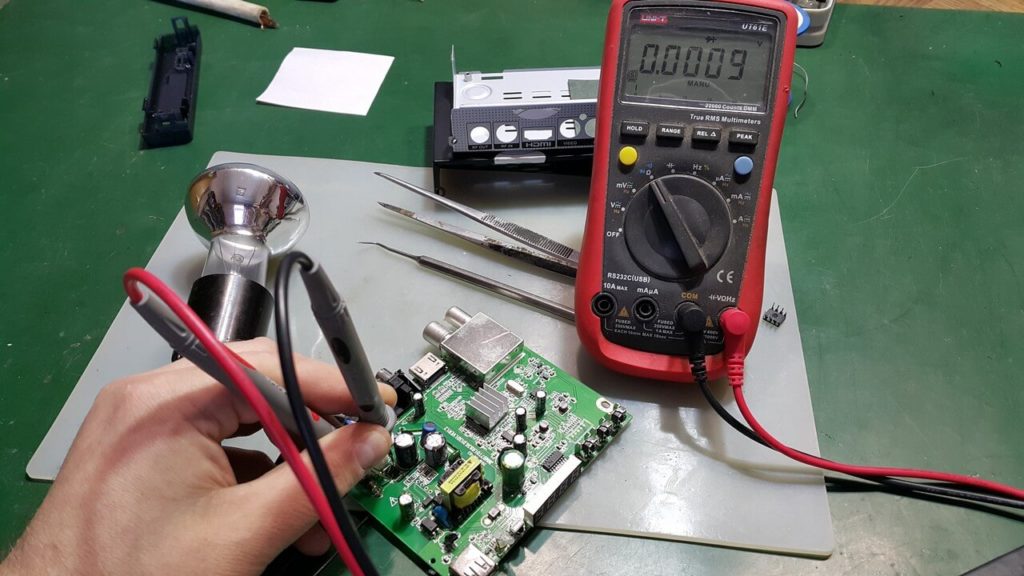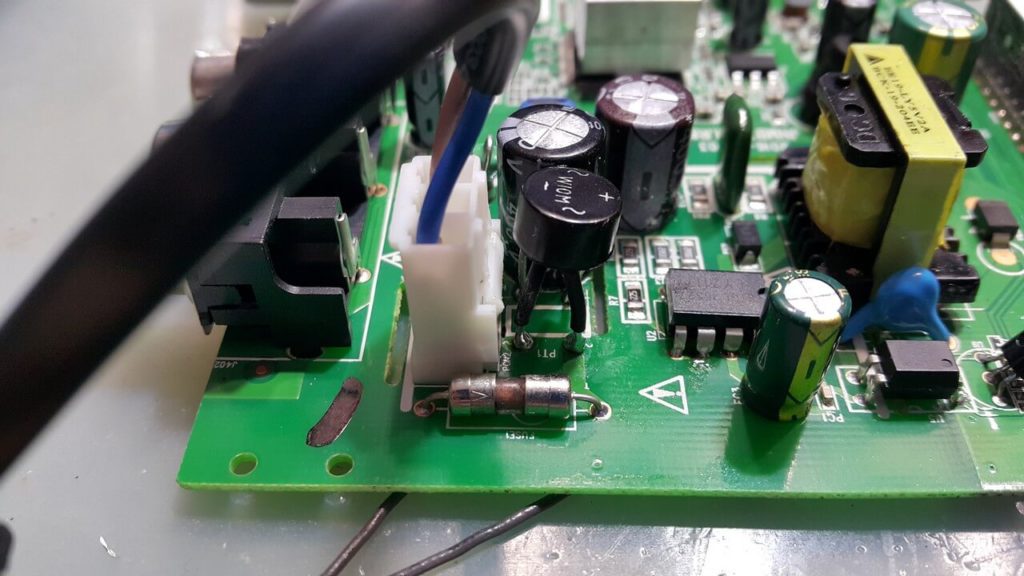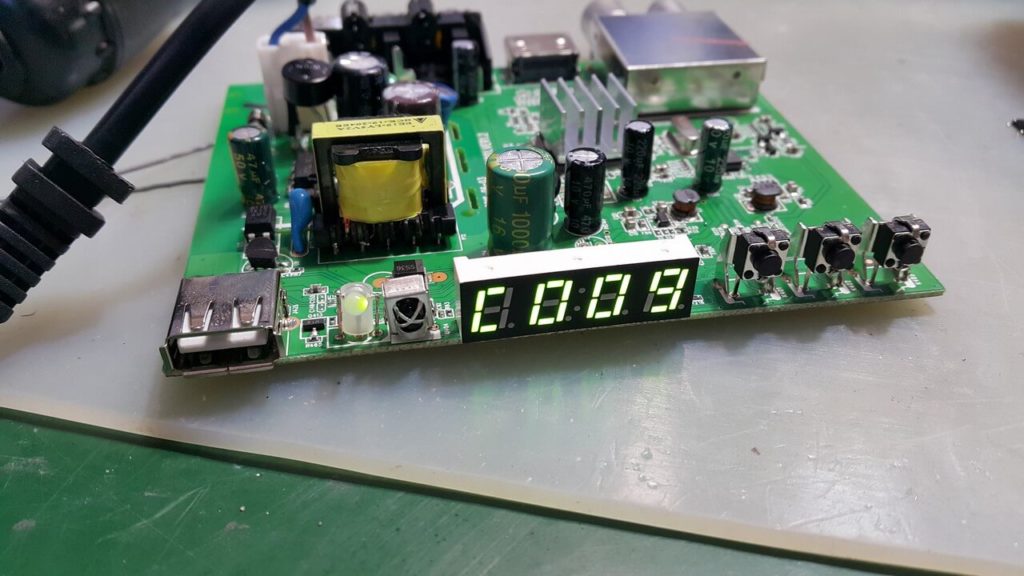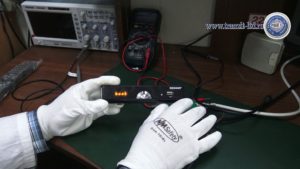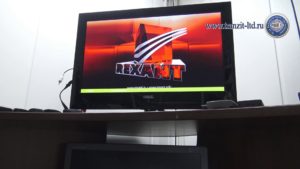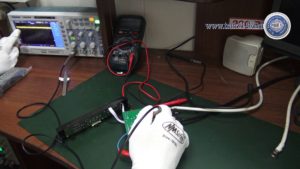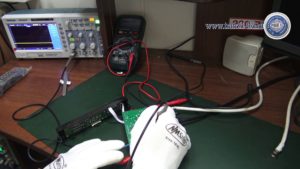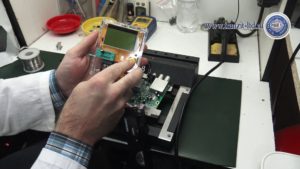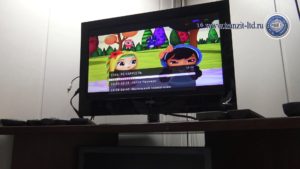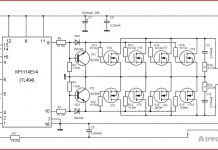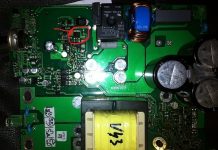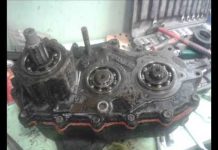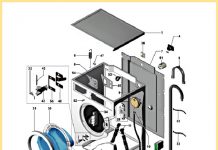In detail: do-it-yourself repair of dtv 2 from a real master for the site my.housecope.com.
Since the late 90s of the last century, audio - video technology has evolved greatly. From VCRs and DVD players, CD and MP3 recorders, to omnivorous media players that allowed you to read media files from a USB flash drive. Such devices cost 3-4 thousand in due time.
Now every DVB-T2 receiver can do it. The receivers are quite cheap - from 900 rubles, and in addition to reading media files from a flash drive, they allow you to watch television with digital quality for free, albeit only 20 channels. And everything would be fine if the Chinese, in pursuit of cheap devices, did not put low-quality parts there. I have had cases when in a receiver with a built-in power supply, after 2 years of operation, a small electrolytic capacitor had an overestimated ESR.
Shallow electrolytic capacitor
And accordingly, the receiver did not turn on, after measuring the equivalent series resistance ESR with a meter, and replacing the three-ruble capacitor, everything returned to normal and the receiver turned on. But this, as they say, was just lucky. More often, DC-DC converters burn out in receivers. Sometimes, fortunately for the user who decides to repair the set-top box on his own, stabilizers with 3 legs are installed instead, the replacement is not difficult, but sometimes the boards have unreliable five-legged converters, we will analyze this case. There are 3 of them - small microcircuits in the SOT-23-5 package.
Chip Converter - drawing
They give respectively 3.3 volts to power the RAM microcircuit, 1.8 volts and 1.2 volts to power the processor.
| Video (click to play). |
Dimensions of converter chip
It is easy to determine where the output of the microcircuit is, even without a datasheet for this microcircuit, the output of the converter is connected by a track with a choke necessary for the operation of the converter. You can familiarize yourself with one of the typical converter circuits by looking at the figure below:
Converter wiring diagram
What if your set-top box refused to turn on, you opened it and, having called, found two or more terminals in a short circuit or low resistance? Such converters, due to the fact that their binding is sometimes individual and incompatible with other types of converters, it is necessary to change them strictly to exactly the same, or in extreme cases to full analogs taken from datasheets.
Converter chip pinout
The wiring diagram, the ratings of the parts, the output current, and of course the output voltage must completely match. I got one of these attachments for repair with a 3.3 volt converter power input punched to the ground. A quick search in the radio stores of our city showed that we have no such microcircuit or complete analogs anywhere else.
Converter to Ali Express Party
And on Aliexpress, they were only in batches of at least 10 pieces, and with expensive paid delivery, which did not suit me. How to be in such a situation? The solution was found and I decided to share it with the readers of this site. Moreover, the output is very low-cost, in terms of the cost of parts in comparison with the purchase of a batch of converters.
Photo converter board
The fact is that for design on arduino and microcontrollers, special small-sized converters, stabilizers are produced in China, immediately with the necessary body kit soldered on the board for their operation. These are AMS1117 stabilizer microcircuits familiar to many electronics engineers.
Stabilizer ICs AMS1117
These microcircuits are produced as adjustable, which is unnecessary for us in this case, and with a fixed voltage at the output, but we are interested in voltages of 1.2, 1.8, 3.3 volts.For all these voltages, ready-made converter shawls are on sale on Aliexpress, based on these stabilizers. How can you distinguish between converter boards, if, for example, you bought them earlier and forgot what voltage they are?
On the case of microcircuits, in addition to the name of the model, stabilizers for a fixed voltage, it is sometimes written the voltage that will be at the output of the converter, that is, the same 1.2, 1.8, 3.3 V we need. How to place these converters in the receiver case? They will not take up much space, I would not think long, MGTF soldered to three of the contacts on the converter board, there are 4 of them: input plus power supply, output plus power supply, and two contacts common for input and output ground.
Why we use three contacts out of four I think it is clear. How can we check ourselves whether we found the correct pinout of the microcircuit if a Chinese datasheet found for example raises doubts? Call the output indicated by the datasheet Vin, often if the set-top box comes with an external power supply, it is directly connected to the power socket. Also, between the ground and the power input, an electrolytic capacitor is often installed on the board, at 220 μF x10 or 16 volts.
Condenser 220 x 25 volts
The plus of the capacitor is connected to the power input of the converter microcircuit. What if you do not know for what voltage this converter was at the output, that is, for what voltage do you need to buy the converter? You can try after dismantling the burned-out microcircuit and cleaning the contacts on the board from solder, supply power to the receiver and measure the supply voltage on the two remaining converters. And determine the voltage at the output of the remaining microcircuit by the elimination method. Solder this burnt-out converter using a hot air gun, or by applying a drop of solder, Rose or Wood's alloy to all contacts, and heating them quickly alternately with a 25-watt soldering iron.
If you are sure that the converter has burned out and are not afraid to burn it with the high temperature of the tip, during dismantling, you can apply a little POS-61 ordinary solder to all the contacts and alternately heat the 40-watt terminals with a soldering iron, trying to move the microcircuit. If, after soldering, it turned out that the short circuit was “underfoot” on the board, and not in the microcircuit, you need to finally make sure of this, clean the contacts of the old soldered converter from solder using a dismantling braid, applying an alcohol-rosin flux to the contacts with a brush (SCF).
SKF alcohol rosin flux
Then just put the braid on top of the contacts and heat the leads over the braid with a soldering iron. The solder will go to a clean braid. The tip of the braid can even be dipped in alcohol rosin flux for better absorption. As the solder is absorbed, the end of the braid should be cut and repeated from the beginning. The same should be done with the contacts on the board left after the soldered converter.
There, as usual, we will have "snot" from the solder applied during dismantling - they must be removed. Then you can solder the MGTF wire connected to the contacts of the converter, finding by the datasheet for this microcircuit where we have the power input, where is the output, and where is the ground. It will be possible to check, as I wrote above, the contact connected to the ground by the minus of the power supply, we can call by touching either the polygon on the board, or if you are a beginner and are not sure of the correctness of the dialing - the metal body of the USB connector.
After everything has been soldered, do not rush to turn on the attachment to the network, wash off the traces of the flux with alcohol, especially if you never know, used a weakly active flux, which in this case is a prerequisite for the long operation of the device. Then look under a strong magnifying glass or take a picture with a phone with a good camera and make sure not to put "snot" on the adjacent contacts, as they are there quite close to each other.
Multimeter in audible dial mode
To be completely sure that there is no short circuit, or if it was not possible to find a strong magnifying glass, ring all adjacent contacts relative to each other for a short circuit with a multimeter in the audible dial mode. All these procedures with replacing the converter make sense only in one case - if, after checking the datasheet, you did not find a short circuit of the power input pins to the power output, since in this case your processor or RAM microcircuit has already burned out due to the supply of an overestimated supply voltage.
DVB-T2 tuner board processor and memory
Which, of course, is sad, since then it will not be realistic to fix it either at home, or even in a good workshop, due to the laboriousness of the repair and its high cost - higher than the cost of a new attachment, it will not make sense.
Any more or less trained radio amateur can easily cope with this repair, and due to the low cost of the board for replacing the converter, it can be recommended as a means, albeit a "collective farm", but a very budget solution, in the absence of extra funds from an economical radio amateur for purchase of a new set-top box. Or there is simply a desire to prove to oneself that the repair of complex digital equipment is quite realistic sometimes to be carried out on our own. Happy repairs to everyone! AKV.
The most common malfunction of digital television set-top boxes is the failure of the power supply. In such an unpleasant case, it is very good if the model of the set-top box was with an external adapter, bought a new one and look further! And if not! And the power supply was built into the box itself? Then you have to repair or purchase a new one. But maybe there is an easy way out!
Hello dear readers! In this article, I want to share one simple repair method that anyone who knows how to hold a screwdriver and a soldering iron can do! Moreover, it is not necessary to master these tools masterfully.
I'm also not going to tell you anything overly complicated in the field of electronics repair, this is the lot of professionals. On the contrary, I will try to describe everything in such a way that even a non-specialist could cope and eliminate this malfunction.
I'll make a reservation right away that this method is not suitable for all models of consoles, but for many, since they are often made according to a scheme very similar for this case. Everything will be based on a specific example of a set-top box from the D-Color company, namely the DC1401HD model. So by understanding this "high technology" you can repair your digital TV box yourself.
Fast navigation through the article
What is a sign that it is the power supply unit that has failed in the console, and not something else? If the set-top box connected to the outlet does not show any signs of life, neither the digital indicator nor the LED on the front panel is lit, then with a probability of 99% the reason is in it, in the power supply.
If, at the same time, the warranty period has already expired, then you can safely do the disassembly. As the experienced masters say, "An autopsy will show" I think you will deal with this part of the work without a detailed description, just be careful, usually two screws on the back wall, sometimes also on the sides allow you to release and open the top cover. Plastic latches on the sides and bottom hold the front panel, and the board itself is also fixed with screws to the bottom of the case and in the area of the connectors on the back of the case.
So, the set-top box is disassembled, the power cord is also removed from the connector, it is no longer needed. On the bottom of the case, there are traces of the "fire" that left behind a burnt-out power supply.
P.S. The power supply unit here is not a separate unit, as you might think from the name, but the section of the board on which the radio elements are located, providing the required power supply voltage for the set-top box.
I will outline the general picture, and for those who already know a little about radio engineering, this will already be enough to grasp the basis of the idea and repeat. So, the power supply circuits of this set-top box give out only one voltage - 5 Volts.Since this circuit has burned out and repair may be impractical (in terms of the total cost of radio components and repairs), that is, a simple solution. Replace the internal power supply with an external one. It's not very difficult!
In the photo above, with a yellow frame, a section of the power supply unit that has failed is highlighted. The board has already been washed, so no traces of burning are visible. By the way - Among the repairmen, the expression "Burnt out" does not always mean literal burning with charring and other similar manifestations, it only means that the radio components are out of order.
For our repair, you will need to purchase an external power supply with an output voltage of 5 Volts and capable of delivering a current of 1.5 or better 2 Amperes. Now there are a lot of similar ones and can be purchased not expensively, or maybe you have a similar one, for example, an unused charger from a tablet or smartphone.
When a suitable adapter is available, it remains to find the desired point on the board of the set-top box and, observing the polarity, apply voltage to it from the external power supply. Everything! It remains to lay and secure the wire, or you can organize a detachable connection, as you like. I think the basics are clear, let's get down to the details.
Just a little bit of basics for those who are not in the subject, so that you can figure it out. Pay attention to the photo. Click to enlarge.
In short, the power supply consists of:
- The primary "Hot" part - Hot, it is called because it is dangerous, connected to the mains voltage of 220 volts. Please note that even after unplugging from the outlet, for some time, there is a charge that can bring brr .. 😯 unpleasant sensations if you climb there. But in our case there is no need to climb there and we will not connect it to the outlet either.
- Secondary part - Safe there, there is a galvanic isolation from the mains. In the given example, at the points indicated in the photo, a voltage of only 5 Volts comes out from the rectifier diode.
In the purchased, external power supply (at least 1.5 amperes, 5 Volts.) We bite off the plug, clean the ends of the wires and, having determined the polarity, we solder them: Positive to the diode terminal, on the side where the strip is drawn on it, and the negative to the common bus - the body of the USB port will be a convenient place for this. If you do not know how to determine the polarity, even without a device, see additional materials at the end of the article.
We connect the new power supply to the network, take it out of standby mode, check what happened.
All OK! It remains to lay and secure the wire so as not to accidentally pull it out, collect everything in a heap and use it. In the end, it will look like this.
If you need ideas on how to attach the wire to the box? How to determine polarity without a device? Or how to solder the wire from the bottom of the board? - Then these additional materials are further in the text.
For those who have a multimeter, it will not be difficult to determine the polarity of the power supply, but what about those who do not have this device?
There are several simple ways:
- You can determine the polarity by the color of the wires. There is a rule - the Red wire is a plus, respectively, the other wire is a minus. This is almost always the case! Nearly! Sometimes there are exceptions, either the wires do not understand what color, or the rule has been violated. 😆
- There is another way, it will be needed - just don't laugh ... potatoes. Yes, yes, raw potatoes! The method is as follows. Cut the potato in half and stick the bare copper wires from the external power supply into it, at a distance of about 5 mm from each other. We plug the PSU into an outlet and wait. With the adapter voltage of 5 volts, it took about three minutes for a visible result. Click on the photo to enlarge.
The potato around the positive wire begins to turn green, so you can accurately determine the polarity without instruments.
In the first, simplest version, the wires were soldered from above, directly to the terminals of the radio components, but you can do it a little differently, run them from the bottom.
In this case, the wire to the case will pass under the board, from the bottom.
On this occasion, hastily prepared a small photo report with a short, step-by-step description of the actions. Hopefully this will be enough.
By the way! Such alteration can be arranged in order to adapt the digital set-top box for use in a car. You just need to use a 5 volt 2 ampere car adapter.
That's all! Success to everyone! I would be glad if this information helps you with something!
If your DVB-T2 digital set-top box for receiving terrestrial digital TV has stopped working, then in some cases you can solve the problem yourself. In this article, we will describe the most common problems that arise when using digital set-top boxes. You will also be able to determine if the viewing problems are a defect in the set-top box itself or the problem is in the antenna or TV.
This is one of the most common breakdowns of digital terrestrial set-top boxes. It manifests itself, as a rule, in two versions: the receiver does not show signs of life at all, or the red indicator of the standby mode is on, but the set-top box does not go into working mode. Most receivers start working immediately after plugging into the outlet and do not need to be turned on from the remote control. If this does not happen, then it is most likely that you have a faulty power supply.
The power supply is a weak point in any technique and digital set-top boxes are no exception. The power supply unit may fail completely - in this case, not a single indicator on the set-top box lights up at all and the device does not react in any way to the connection to the 220V network. But it often happens that the power supply unit produces an underestimated voltage or current. In this case, the tuner “tries to turn on” giving some signs of life, but does not go into operation mode.
Solution: If the power supply is external (as in the picture), then it is easy to solve this problem on your own. Power supplies for set-top boxes are usually standard and interchangeable, even of different models and manufacturers. You just need to make sure that the new power supply unit outputs a voltage of 5V and has the same plug at the end of the wire as the old one. You can buy it in specialized stores that sell antenna equipment. In most cases, you can ask your dealer to plug the power supply into your receiver and make sure the problem is resolved.
It is more difficult if the power supply is built into the console. The characteristic feature of the internal power supply unit is a regular plug at the end of the wire. In this case, the power wire is not disconnected from the set-top box itself, as is the case in the external version. In this case, it is best to contact a service center for repair.
This defect is quite rare, but if it is detected, repairing the receiver is most often impractical. A clear sign of such a malfunction: the appearance of image distortion and "freezing" of the picture, which appears 5-20 minutes after turning on the digital tunerafter which the problem persists. Similar symptoms occur with a weak signal from the antenna, but in the latter case, image distortions do not have a clear connection with the duration of the DVB-T2 receiver.
The problem may be the same power supply or processor overheating. If the power supply is external, you can try to connect another power supply unit. If not, then the matter is in the processor itself and the repair of the product in this case is inappropriate.
I have two TVs in my house and both of them work through Cadena dvb-t2 consoles and it turned out that at about the same time both of them stopped working. Repair of such a set-top box costs about 600 to 800 rubles, a new one costs from 1200, it turns out it is so and so expensive.It was decided to try to fix it on our own, for this “googling” the vastness of the Internet, a solution was found, which I want to show you. As it turned out, this is one of the main breakdowns.
The main symptoms of a breakdown of the console:
- when the set-top box is connected to the network, the red indicator lights up and the set-top box does not react to anything else.

First of all, we disassemble the attachment and carefully examine its insides, special attention should be paid to capacitors. As shown in the photo (circled in red), the capacitor is swollen, unlike the capacitor (circled in blue), therefore it is no longer working and must be replaced.

Then we solder the capacitor, look at the parameters and look for a suitable one. In this case, you need 10 volts and 1000 microfarads, as well as 105 degrees Celsius. But in my case, only 10v1000mph and 95Hz were available, and it is slightly smaller in size, but as practice has shown, it works great.

Now we solder the new condo in place of the old one and, as you can see in the photo, everything is fine. (marked in blue).

We check the prefix for operability and put the case back.

I also recommend watching a video clip in which there are moments that were not included in the photo report.
Information
To leave your comment - register or enter the site under your name.
Hello everyone. Today they brought the receiver after a thunderstorm DVB-T2 Color DC1302HD with a malfunction does not turn on, as the client said that there was a thunderstorm and knocked out plugs in the electricity meter and after turning on the light the receiver no longer worked.
We take the board out of the case and visually inspect it. After examining the receiver, a blown fuse was found, this can happen for two reasons, it is a faulty diode bridge or a PWM controller.
For further troubleshooting, you need to check the primary power circuits. We install the tester probes on the network capacitor and check for a short circuit. As you can see in the photo, we do not have a short circuit.
Next, we check the integrity of the network capacitor, it may fail due to overvoltage, the capacitor is alive.
In order to plug the receiver into an outlet and check how it behaves, I installed a 40-watt incandescent lamp in the fuse place so that we would not have fireworks.
After plugging into the outlet, our light is constantly on - this means that there is an overload in the primary circuit.
Next, we check the diode bridge, I did not immediately think to check it and immediately dropped the PWM controller, here the LY2117 is installed, another Chinese hack, I could not even find a PDF on it, but let's not be distracted. As it turned out, we have a diode bridge in a short circuit, most likely in it is the problem of a blown fuse.
I installed a diode bridge W10M here is a datasheet, I could not find a suitable one to install here anymore.
Next, change the 2 amp 250 volt fuse and turn on the receiver.
All repairs are over, we assemble the receiver and install it for testing.
And now, so to speak, the repair manual
Capacitors:
1 - Problems with the image on the AV output (no image, noise in the picture), sound claps.
8 - Does not start - hangs on the boot; the splash screen appears, and then the blue screen again. In this case, the capacitance, when measured, can correspond to the nominal (low ESR of the capacitor).
9 - Does not turn on - there is no image at all
13 - seems to slow down too
14 - the picture slows down, the image is strewn.
15 is the same as 14, but 14 is more important.
"Does not catch channels" - quartz between C13 - C15
Capacitors in the power supply:
These two capacities affect the performance of the power supply. The power supply unit either does not work at all (output voltage is 0V) or gives a low voltage of 1.7V.
Container 2 swells - you can see it or the insides come out from below.
2. Output AMS1117 - 1.8 V, if there is no such value - go to point 3
3. It should be 3.3v, if there is no such thing, then the problem is in the capacitor nearby or in the AS11D itself
4.There should be 1.34 V, but even if there is so much, then the problem is still, most likely, in the capacitor - it is better to change it. In this case, nodes 2 and 3 show normal stress values. This is the case when the receiver starts to load and cannot completely do it - the problem is in the capacitor of node 4. AS11D in this node is also not excluded, but the probability of its malfunction is very small, compared to the probability of poor capacity.
THE LARGEST NUMBER OF FAILURES RELATED TO CAPACITIES 8 AND 9 (SEE 1 PHOTO) IF EVEN THE PROBLEM IS NOT IN THEM, WE CHANGE THEM AS A PREVENTION.
Click on the photo! Repair dvb t2 Rexant 511
Repairing a dvb t2 set-top box is a process that requires time, tools, knowledge. Let's try to repair the free digital TV box today. We will show you how the repair process goes. It is possible that this review will help someone fix their receiver.
The defect is that our set-top box works visually. But after the boot message appears, our receiver does not want to show the menu and the TV picture.
Rexant 511 is broken, we are repairing it.
A splash screen appears on the TV screen and then the receiver freezes. This process goes through both the HDMI cable and tulips. In order to find a malfunction, we disassemble our receiver. We will not talk about safety precautions, all the default standards must be observed.
Repair dvb t2 Rexant 511 using an oscilloscope.
For diagnostics, we need an oscilloscope. We turn on the devices, set the necessary modes. We take the probe from the oscilloscope and start checking the readings on the main board.
Repair dvb t2 receiver yourself
As a result of diagnostics, we identify the alleged malfunction. There is a capacitor on the board, which is normal by all visual signs. After taking measurements, the capacitor shows deviations from the technical characteristics declared by the manufacturer. Accordingly, it does not fulfill its functions.
Dvb t2 repair, capacitor check.
We solder our problem capacitor. For control, we check the capacitor, we do it in a special device, we measure the ESR of electrolytic capacitors. We see that our diagnostics were correct, the capacity has deviations.
We take a good capacitor. We check on the device whether it can be put into the board. We solder it into our main board. It should be borne in mind that you must act carefully and follow the safety rules.
dvb t2 prefix after repair.
After replacing the capacitor, you can turn on the attachment and check. We need to do this in order to check if we need to look for something else or not. In this case, you do not need to solder anything else. Our prefix works!
If you still have questions, you can watch the video.

